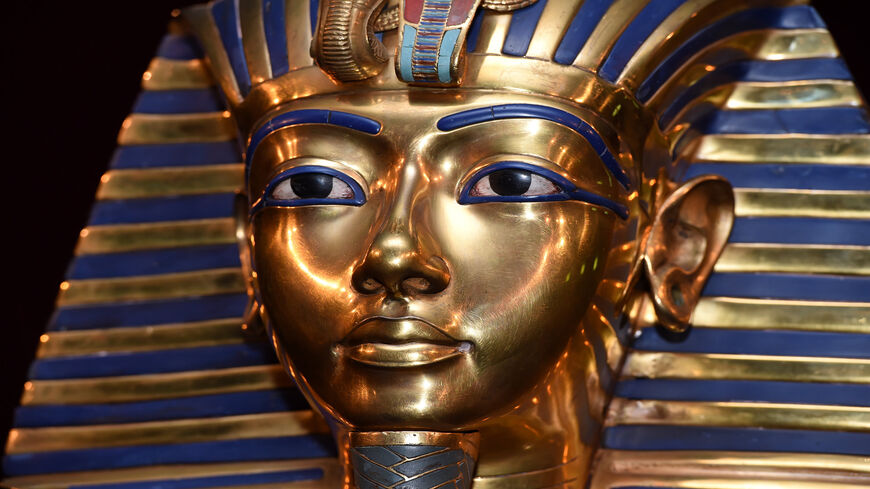CAIRO — British newspaper Express published July 16 an article quoting a passage from the book of "The Valley of Kings: The Egyptian Golden Age," by English Egyptologist professor Joann Fletcher.
In a detailed account, Fletcher argues that the famed mask of Tutankhamun was originally made for another famous ruler, and it may have belonged to a woman, which was Queen Nefertiti.
Fletcher based her theory on the examination of photographs and records of the excavation and the discovery of King Tut's intact tomb by Howard Carter in 1922. According to her, the mask shows a pharaoh with pierced ears. Meanwhile, when he died at the age 20, Tut "would not have been portrayed with pierced ears," Fletcher said.
"This mask was not made for an adult male pharaoh — when the gold was compared, [they found] the face is made of completely different gold to the rest. Evidence of soldering is clearly visible on the mask. It now seems as if Tutankhamun's own face was effectively grafted onto the mask of the previous ruler," she explained.
Tutankhamun is considered the most famous king of Ancient Egypt, especially in the 18th Dynasty (1336-1327 B.C.). Despite his short rule, which lasted nine years only, his international fame is due to the sensational discovery of his intact tomb in the Valley of the Kings in Luxor governorate, southern Egypt, in 1922. The cemetery included some 5,000 artifacts, all in good condition.
Until this day, the discovery of the tomb is seen as one of the most significant archaeological breakthroughs.
The famous mask was designed to protect the mummy's face through a magical formula engraved on its back, according to the Egyptian Ministry of Antiquities' website.
Former Minister of Antiquities and Egyptologist Zahi Hawass told Al-Monitor, "Fletcher's theory about the ear piercing is unfounded because all the 18th Dynasty's rulers wore earrings during their period of rule."
He noted, "The mask does not bear the name of Queen Nefertiti, which was confirmed by a German archaeologist when he examined it when the mask's chin area was being restored after it was damaged back in October 2015."
The golden mask is currently housed in the Egyptian Museum in central Cairo. It weighs more than 10 kilograms (22 pounds) and is 54 centimeters (1.8 feet) high. It has two mixtures of gold: 18.4 carats for the face and neck and 23.4 carats for the rest of the mask.
The mask is a face cover for a ruler with a false beard, holds a three-branched necklace and is topped by the royal insignia of a cobra and a vulture for protection. It also has holes in the ears for earrings.
Hussein Abdel Baseer, director of the Antiquities Museum of the Bibliotheca Alexandrina, told Al-Monitor, "There has always been controversy about King Tut's mask, which was previously said that it belonged to Queen Meritaten of the 18th Dynasty and daughter of Pharaoh Akhenaten, which is not true."
"It is true that some of the treasures found in King Tut's tomb did not belong to him, but to other rulers during the Amarna Period. But the mask did indeed belong to him," he added.
"When it comes to the ear piercings, it was a natural and common thing among kings. Earrings were not limited to women — or children — in the case of King Tut. It is also worth mentioning that some of the rulers of ancient Egypt took hold of the treasures of kings who preceded them and attributed them to themselves. But this is something that can be verified through examination," Abdel Baseer said.
He added, "It is different in the case of King Tut's gold mask because it bears little indication that it might have belonged to someone else."
He explained the difference in the color of gold on the upper part of the mask compared to the rest of it, arguing that the yellow-golden color was associated with the worship of God Aten, in the Amarna period, and who was symbolized by the sun.
Bassam al-Shamaa, a tour guide and Egyptology writer, told Al-Monitor the funerary mask for kings did not necessarily bear the real features of deceased kings, but usually takes the form of God Osiris, the god of death and resurrection.
Shamaa concurred with views regarding ear piercings, explaining, "The antiquities found in King Tut's tomb included a set of earrings, and therefore we could not assume that the mask belonged to a woman or to Nefertiti in particular."
He said, "Queen Nefertiti was not King Tut's mother but his father's wife and therefore it is far-fetched that he would get her belongings."
Shamaa concluded, "The golden mask bears a hieroglyphic text engraved on its back, which is a magical writing like a spell, the purpose of which is to help the deceased in the pass over to the other world. The writings mentioned several names usually used to refer to King Tut like, 'Ra and Nebra' among other names, which completely refutes Fletcher's theory."








:quality(70):focal(150x126:160x136)/cloudfront-eu-central-1.images.arcpublishing.com/thenational/GXMNQESSY5AXDB2TUXMXYKLDQQ.jpg)



